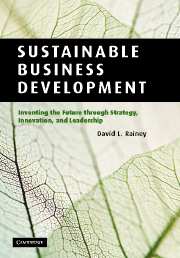Book contents
- Frontmatter
- Contents
- List of figures
- List of tables
- List of boxes
- List of abbreviations
- Acknowledgments
- Introduction
- Part I Enterprise thinking, the driving forces of change, and leadership
- 1 Sustainable business development: overview and guiding principles
- 2 Enterprise thinking and the strategic logic of strategic business development
- 3 Crafting sustainable business strategies and solutions
- 4 The driving forces of social-, economic-, and environmental-related change
- 5 The driving forces of markets and stakeholders' connectedness
- 6 Crafting a sustainable enterprise through leadership and capabilities
- Part II Innovation management, life cycle considerations, and insights
- Glossary
- Select bibliography
- Index
- References
3 - Crafting sustainable business strategies and solutions
from Part I - Enterprise thinking, the driving forces of change, and leadership
Published online by Cambridge University Press: 04 December 2009
- Frontmatter
- Contents
- List of figures
- List of tables
- List of boxes
- List of abbreviations
- Acknowledgments
- Introduction
- Part I Enterprise thinking, the driving forces of change, and leadership
- 1 Sustainable business development: overview and guiding principles
- 2 Enterprise thinking and the strategic logic of strategic business development
- 3 Crafting sustainable business strategies and solutions
- 4 The driving forces of social-, economic-, and environmental-related change
- 5 The driving forces of markets and stakeholders' connectedness
- 6 Crafting a sustainable enterprise through leadership and capabilities
- Part II Innovation management, life cycle considerations, and insights
- Glossary
- Select bibliography
- Index
- References
Summary
Introduction
Understanding the business environment and formulating and implementing strategies for sustainable success are two of the most critical responsibilities of corporate management and strategic leadership. Regardless of the corporation's strategic position, its technologies and products, the forces of change in the global business environment require that a corporation has to continuously make dramatic improvements in order to stay on the leading edge. The rapidly changing life cycle of technologies and products suggests that maturity and decline are inevitable and that reinventing the corporation and its product portfolios and capabilities is an ongoing process. Even the most powerful strategic positions and competitive advantages erode over time.
Strategic leadership must integrate enterprise thinking and SBD throughout the corporation. Corporate leaders have to weave them into the decision-making processes. Strategic leadership involves making decisions about space (positions and movements), time (the present and future), mass (capabilities, resources, and money), and energy (knowledge, learning, and action). It must be dynamic and focused on the future “space–time” dimensions and the corporation's movements across those dimensions. Strategic management must integrate people, capabilities, resources, and relationships across the entire enterprise and all it touches. It must assure that the business constructs are analyzed, selected, and adapted sufficiently in advance to meet the needs of the future and address the challenges of the changing business landscape.
The process of crafting sustainable business strategies involves making judgments about the future business environment and shaping a new reality of five, ten, or even twenty years into the future.
- Type
- Chapter
- Information
- Sustainable Business DevelopmentInventing the Future Through Strategy, Innovation, and Leadership, pp. 150 - 212Publisher: Cambridge University PressPrint publication year: 2006



